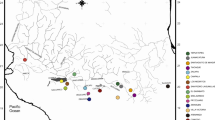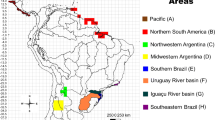Abstract
Phylogenetic systematics was used to reveal micro-evolutionary processes and macro-evolutionary patterns that have resulted in the current distribution of species of the live-bearing fish genus Brachyrhaphis. A previously constructed molecular phylogeny for the genus determined that two distinct clades, deep-bodied and slender-bodied, exist within the genus. Micro-habitat variables were measured for all extant members of the genus. Water flow differed significantly between the clades and was converted to a discrete variable and, along with elevation and micro-habitat type, mapped onto the phylogeny for the genus. The evolution of micro-habitat choice was hypothesized using these results. A detailed distribution map was constructed to unveil biogeographic patterns and was also interpreted in light of the molecular phylogeny. The phylogeny was then used to construct an area cladogram. This cladogram was compared to the one derived from paleogeography. The molecular-based area cladogram adds to the growing database required to resolve the biogeography of the Caribbean.
Similar content being viewed by others
References cited
Brooks, D.R. & D.A. McLennan. 1991. Phylogeny, ecology and behavior: a research program in comparative biology. University of Chicago Press, Chicago. 434 pp.
Bussing, W.A. 1985. Patterns of distribution of the Central American ichthyofauna. pp. 453–473. In: F.G. Stehli & S.D. Webb (ed.) The Great American Biotic Interchange, Plenum Pub. Corp., New York. 532 pp.
Endler, J.A. 1983. Natural and sexual selection of color patterns in poeciliid fishes. Env. Biol. Fish. 9: 173–190.
Endler, J.A. 1992. Signals, signal conditions, and the direction of evolution. Amer. Nat. 139 (Suppl): S125–S153.
Funk, V.A. & D.R. Brooks. 1990. Phylogenetic systematics as the basis of comparative biology. Smithsonian Contr. Bot. 73: 1–45.
Graybeal, A. 1993. The phylogenetic utility of cytochrome b: lessons from bufonid frogs. Mol. Phyl. Evol. 2: 256–269.
Humphries, C.J. & P.R. Parenti. 1986. Cladistic biogeography. Clarendon Press, Oxford. 98 pp.
Maddison, W.P. & D.R. Maddison. 1992. MacClade: analysis of phylogeny and character evolution, 3rd ed. Sinauer Associates, Sunderland. 398 pp.
Meffe, G.K. & F.F. Snelson, Jr. (ed.). 1989. Ecology and evolution of livebearing fishes (Poeciliidae). Prentice Hall, Englewood Cliffs. 453 pp.
Meyer, A., J.M. Morrissey & M. Schartl. 1994. Recurrent origin of a sexually selected trait in Xiphophorus fishes inferred from a molecular phylogeny. Nature 368 (6471): 539–542.
Meyer, A. & C. Lydeard. 1993. The evolution of copulatory organs, internal fertilization, placentae, and viviparity of killifishes (Cyprinodontiformes) inferred from a DNA phylogeny of tyrosine kinase gene X-src. Proc. Royal. Soc. (London) 254 Series B: 153–162.
Miller, R.R. 1966. Geographical distribution of Central American freshwater fishes. Copeia 1966: 773–802.
Mojica, C.L., A. Meyer & G.W. Barlow. 1997. Phylogenetic relationships of species of the genus Brachyrhaphis (Poeciliidae) inferred from partial mitochondrial DNA sequences. Copeia 1997: 298–305.
Page, R.D.M. & C. Lydeard. 1994. Towards a cladistic biogeography of the Caribbean. Cladistics 10: 21–41.
Parenti, L.R. & M. Rauchenberger. 1989. Systematic overview of the poeciliines. pp. 3–12. In: G.K. Meffe & F.F. Snelson, Jr. (ed.) Ecology and Evolution of Livebearing Fishes (Poeciliidae), Prentice Hall, Englewood Cliffs.
Platnick, N.I. & G.N. Nelson. 1978. A method of analysis for historical biogeography. Systematic Zoology 27: 159–188.
Rosen, D.E. 1978. Vicariant patterns and historical explanation in biogeography. Systematic Zoology 27: 159–188.
Rosen, D.E. 1985. Geological hierarchies and biogeographic congruence in the Caribbean. Ann. Missouri Bot. Gard. 72: 636–659.
Rosen, D.E. & R.M. Bailey. 1963. The poeciliid fishes (Cyprinodontiformes), their structure, zoogeography, and systematics. Bull. Amer. Mus. Nat. Hist. 126: 1–176.
Savage, J.M. 1982. The enigma of the Central American herpetofauna: dispersals or vicariance? Ann. Missouri Bot. Gard. 69: 464–547.
Author information
Authors and Affiliations
Rights and permissions
About this article
Cite this article
Mojica, C.L. Comparative ecology and historical biogeography of the genus Brachyrhaphis. Environmental Biology of Fishes 51, 117–127 (1998). https://doi.org/10.1023/A:1007415928796
Issue Date:
DOI: https://doi.org/10.1023/A:1007415928796




